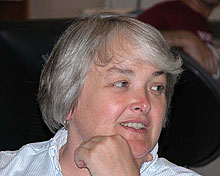
Dr. Deborah Kelley, Co-chief Scientist.
Meet the Lost City Scientists at UW
July 21, 2005
The UW-Hosted Science Team
Today the team, our team of scientists, began to gather at the University of Washington. Each of our scientists has a particular area of interest. Get acquainted with them as they describe their hopes and goals for this expedition.
Dr. Deborah Kelley
Co-chief Scientist
In 2000, I was part of a team of scientists funded by the National Science Foundation (NSF) to investigate how the Atlantis Massif formed. During this project, we discovered the Lost City Hydrothermal Field. On that program, we had one dive with the human occupied submersible Alvin to the field, during which we recovered a few samples of rocks and fluids. These initial samples and corresponding images showed us that Lost City was unlike any vent field ever seen before, hosting 60 m tall (~200 feet) carbonate towers. Fluids venting from the towers, at temperatures up to 91degrees C, contained high concentrations of the gases methane and hydrogen. These gases supported novel microorganisms that thrived both on the outside of the chimneys and within their walls.
This exciting, and serendipitous find set off a chain of events that has lead to this Ocean Exploration Program. This discovery rocked many in the science community because it showed that submarine volcanoes were not necessary to drive hot spring systems on the seafloor. Instead heat derived from mineral-fluid reactions beneath the field may in part drive hydrothermal flow. In addition, this field may be a close analogue for some of the hot spring systems that developed on early Earth.
Because of the importance of this discovery, NSF again funded us in 2003
to go back to this remarkable, magical place ![]() .
I was fortunate enough to co-lead this expedition, pulling together a
wonderful multi-disciplinary team of scientists from across the US and Europe
that would investigate the linkages among geological, chemical and biological
processes, central to why Lost City is the way it is. When Bob Ballard
asked me if I would help lead this program, there was no hesitation in which
team I would pull together to revisit the field and continue its exploration--the
same team that was there in 2003. I feel incredibly lucky to work
with the people that make up this team. They are my friends and collaborators
and a true joy to work with.
.
I was fortunate enough to co-lead this expedition, pulling together a
wonderful multi-disciplinary team of scientists from across the US and Europe
that would investigate the linkages among geological, chemical and biological
processes, central to why Lost City is the way it is. When Bob Ballard
asked me if I would help lead this program, there was no hesitation in which
team I would pull together to revisit the field and continue its exploration--the
same team that was there in 2003. I feel incredibly lucky to work
with the people that make up this team. They are my friends and collaborators
and a true joy to work with.

Dr. David Butterfield, Vent Fluid Chemist.
Dr. David Butterfield
Vent Fluid Chemist
In this return to the Lost City field, we are hoping to fill in some of the missing pieces from the 2003 expedition. My part of the science of this expedition is fluid chemistry and how it relates to geological and microbiological processes. The LC fluids are unlike any other known fluids. They have a very high pH (from 9.5 to 11) and extremely low metal content. There is some subtle variation in the composition of fluids from different points in the field. This is something we noticed while on board in 2003. There may be a pattern to the variations, and we are hoping to collect samples from enough different points within the field to clearly establish the pattern of variation and look into what is causing it. Are these variations due to very shallow processes that occur within the large carbonate structures or are they related to deeper processes? How deep do fluids circulate under the large carbonate structures? What measurable effects do microbes living on or within the structures have on the chemical composition of the fluids? Can we pinpoint distinct microbial habitats where differences in temperature and composition correspond to different microbial populations? These are some of the questions we hope to answer with the exploration and sampling that we will do on this current expedition to Lost City.
In addition to doing more work in the Lost City field, it would be fantastic to locate another vent field like the Lost City in this part of the ocean. There must certainly be other examples of vents driven by serpentinization, and we could double the inventory by finding just one more. Our first dive target gives us a chance at a new discovery.
For a chemist, it is somehow incongruous to be involved in a "virtual cruise" or do science by telepresence. It will be an interesting experience to watch water samples taken from thousands of miles away. Fortunately, we have Kevin Roe, an excellent chemist, on board to look after all of the details of collecting and processing samples. The team of four scientists from the UW and WHOI will be very busy pursuing their own goals and acting as the hands for all of the scientists on shore.
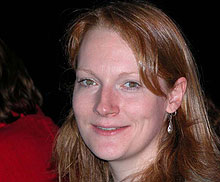
Adelie Delacour, Geologist and Ph. D student.
Adelie Delacour
Geologist
Ph. D student
'Lost City' sits on the Atlantis Massif, which is mainly composed of serpentinites with some gabbroic rocks. The serpentinites result from the alteration of the peridotites by seawater, which circulates through them via fractures. To understand the Lost City hydrothermal system, we need to know how the seawater chemically influences the rocks, which in turn affect the composition of the hydrothermal fluids coming out from the chimneys. By using isotopic systems and geochemical analyses, it is possible to determine the effect of the seawater on the serpentinites. With this cruise, I will hope to get more samples of the serpentinites and gabbros to study their chemical compositions in order to better understand this seawater-rock interaction for Lost City.
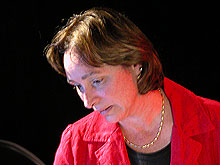
Dr. Gretchen Früh-Green, Petrologist and geochemist.
Dr. Gretchen Früh-Green
Petrologist
Geochemist
I have been studying serpentinization processes for many years and have particularly been interested in rocks that formed in ancient systems similar to Lost City. For me the discovery of Lost City has been an exciting and unique opportunity to sample an active serpentinite-driven hydrothermal system and to better understand this fundamental process that occurs in different tectonic environments and has likely been going on since the Earth's early history. I am particularly interested in the inorganic rock-seawater reactions in the basement and how the by-products of these reactions influence the biological communities that are supported in these high pH systems. By looking at the minerals and by measuring the chemical and isotopic compositions of the rocks and the fluids, we hope to better understand the links between the processes that occur at depth and in the towers, the chemistry of the fluids, the organic geochemistry and the biology.
Together with colleagues at the Swiss Federal Institute of Technology, ETH (don’t know what this stands for), I will particularly be using the isotopic signatures of carbon, nitrogen, sulfur, oxygen, and hydrogen to address questions, such as: What are the sources of carbon and sulfur in this system? What chemical species do the microbes use as their energy sources? How does the chemical composition of the rocks and the fluids change during the life-time of this system? What mineral-fluid or microbe-fluid interactions are controlling these changes? What is structurally and tectonically controlling fluid output? The results of our earlier studies indicate that the chemical signatures of these processes may be very different and have shown us that these highly alkaline hydrothermal systems represent another extreme environment, in which life may thrive.
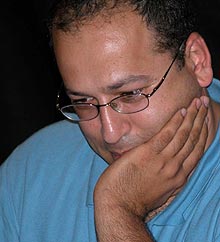
Dr. Peter Girguis, Geomicrobiologist.
Dr. Peter Girguis
Geomicrobiologist
"People occasionally stumble upon the truth, but most of them pick themselves up and hurry along as if nothing happened"
-Winston Churchill-
This is one of the most unique expeditions I have been involved with, and I hope that we as a group demonstrate the effectiveness of these "virtual cruises." This program, with its ability to broadcast high definition video to groups around the world, provides a great many people with the opportunity to participate in discovery and exploration. For example, we were sitting here last night eating burritos, listening to music, and watching the ROV Hercules sitting aboard the Ronald H Brown as it cruised towards the Lost SeaCity! It is just amazing, and I am glad to be a part of this experience. As for my own research, I hope to get some samples from different parts of the Lost City in order to study the microbial communities found in this environment. In particular, I want to understand how different microbial types live off the chemicals made by other microbial types (i.e. the microbial food chain). We know so very little about what microbes on earth do, how they live in communities, how they tolerate (and even eat) chemicals that are poisonous to us, and how they literally control the major processes that support all life on Earth. While no one person can tackle all of these questions, we each try to work on one piece of the puzzle with the hopes that we as a community will better understand these tiniest of life forms.
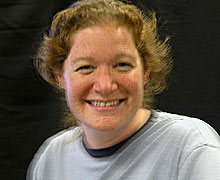
Deb Glickson, Geologist and Ph.D. student.
Deb Glickson
Geologist
Ph.D. student
I am particularly interested in using various mapping tools to better understand spatial relationships between seafloor geology and the distribution of hydrothermal flow. During the 2003 expedition, the autonomous underwater vehicle ABE was used to create a high resolution map of the vent field and the southern portion of the Atlantis Mmassif, which has become the foundation for planning the Hercules dives of the 2005 expedition. This map was also the central feature of the Lost City GIS (Geographic Information System), a database we successfully used in 2003 to integrate fluid, rock, and biology samples, CTD casts, and submersible dive tracks with bathymetry. During this expedition, the geology data we collect will be examined within the GIS, adding to our knowledge of the spatial relationships of faults, chimneys, fluid chemistry, and biology within the field.
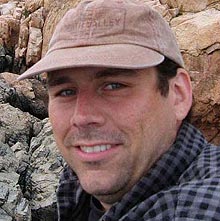
Dr. Nick Hayman, Geologist.
Dr. Nick Hayman
Geologist
The Lost City Field sits on top of the Atlantis Massif, a mountain that required tectonic processes to develop. One process is faulting that allows slip between rock units. A second process is veining, essentially fracturing that was accompanied by crystallization of minerals from fluids. The fluids that flow through veins and faults feed the vents at Lost City. Thus, this project is at the intersection of hydrothermal and geological studies. I hope to use imaged, and possibly sampled, veins and faults to study the linkage between the flow of fluids and the tectonics of the massif.
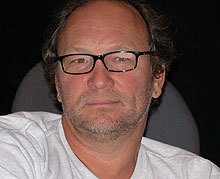
Dr, Jeff Karson, Geologist.
Dr, Jeff Karson
Geologist
My specific interest in the expedition is in the geology of the areas we will explore. The history of the hydrothermal vents and the mountains that they are perched upon is "written" in the rocks we will be able to examine and sample. My particular interest is in the major fault zones in the area. Movement on giant fractures in the Earth are responsible for bringing mantle rocks called "peridotites" to the surface where they react with seawater in a reaction called "serpentinization." This reaction creates the fluid chemistry and heat for hydrothermal vents like the Lost City. Young faults also provide the pathways that allow fluids to circulate through the rocky foundation of the seafloor. We are going to be able to map out both of these types of fault zones in this project. This will allow us to better understand the Lost City site but also how to find other hydrothermal sites.

Kristin Ludwig, Geologist and Ph.D student.
Kristin Ludwig
Geologist
Ph.D student
My current research focuses on determining the age of the carbonate chimneys at Lost City using uranium and thorium isotopes. For this expedition, I am particularly interested in collecting samples of old carbonates. From previous work using carbon-14 dating techniques, we know that the field is at
least 30,000 years old (Fruh-Green et al., 2003). However, these dates are based on the seven samples collected when the field was discovered in 2000. Preliminary results from analyses on the 2003 samples indicate that the field may be much older.
There are several reasons for why we want to know the age of Lost City. On a large scale, knowing the age of the carbonates will help us better understand the relationship between the development of the vent field and the structural geology of the Atlantis Mmassif. We can also try to match the dates of individual chimneys to their geochemistry and petrography to better constrain how the chimneys form and change over time. Finally, the age and chemistry of the structures may give us new insights on the habitats of the diverse microbes and macrofauna that thrive at Lost City.

Dr. Mitch Schulte, Organic Geochemist.
Dr. Mitch Schulte
Organic Geochemist
As an aqueous organic geochemist and a geomicrobiologist, I am interested in the chemistry that occurs during reactions between water and the rocks at Lost City known as serpentinization. These reactions generate hydrogen that can reduce carbon dioxide into organic compounds and can serve as an energy source for microorganisms such as methanogens. Specifically, I will be collecting fluid samples from active vents to analyze for organic sulfur compounds that can potentially be generated abiotically. I will also collect rock samples to look for mineralogical and textural evidence of the serpentinization process. Lost City may also be analogous to locations on Mars where life may have existed, so I’m applying lessons from Lost City to the search for life on other planets.
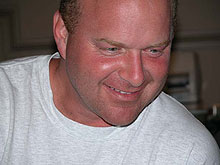
Dr. Tim Shank, Biologist.
Dr. Tim Shank
Biologist
The tight coupling between geological processes and living organisms at hydrothermal vents provides a singular opportunity to study how fundamental planetary processes shape the evolution of life. These tightly linked geological-biological systems have yielded a global network of extraordinarily productive chemosynthetic communities. Animals living at Lost City dwell along cracks of highly sculpted and porous carbonate structures. Our work to date has identified over 65 species inhabiting Lost City, almost all less than an inch in size, including gastropod snails, shrimp-like crustaceans, polychaete worms, and bivalves can be found in these amazing structures.
The Lost City vent field features many components that offer opportunities to identify novel ecological niches and new species (with new adaptations) associated with potentially unique (yet prevalent) chemical habitats. Through the examination of animals endemic to Lost City on this cruise, I hope to gain novel insights into ecology of fauna living in these chemosynthetic habitats. During this expedition, we will collect animals (mostly meiofauna) and the fluids in which they are living to define the different geochemical conditions and the specific relationships of the fauna to particular chemical habitats. We will also examine stable isotopic signatures of the collected fauna to assess what the animals are feeding on, or their trophic relationships, within the field.
There are several key features about Lost City that also offer opportunities to identify the evolutionary relationships of chemosynthetic fauna through genetic comparisons to those endemic to vents and seeps. Through the comparison of DNA among Lost City fauna with other chemosynthetic fauna living at hydrothermal vents on the Mid-Atlantic Ridge and North Atlantic hydrocarbon seeps on the margins of North America and Africa, I will examine how the close proximity (<15 kilometers) to, yet pronounced depth difference (greater than 3000m) above the Mid-Atlantic Ridge floor, and unique fluid chemistry (e.g., pH >10) derived from serpentinization reactions and production of carbonate chimneys at the seafloor.
Sign up for the Ocean Explorer E-mail Update List.


























